Report: Quantitative Data Analysis of Employment and GDP in UK
VerifiedAdded on 2023/06/11
|10
|2714
|96
Report
AI Summary
This report provides a quantitative analysis of the relationship between employment and GDP in the UK, utilizing data sourced from the Office for National Statistics (ONS) from 2012 to 2021. The analysis includes descriptive statistics and regression analysis to determine the correlation between the two variables. The literature review explores various perspectives and theories related to employment and GDP, highlighting the importance of these economic indicators. The findings suggest a weak correlation between employment and GDP, with the regression analysis indicating that changes in employment have a limited impact on GDP. Visualizations of the data further illustrate the trends in employment and GDP over the specified period. The report concludes that while there is a positive correlation, other factors significantly influence both employment and GDP, leading to the acceptance of the null hypothesis that there is no significant relationship between the two variables.
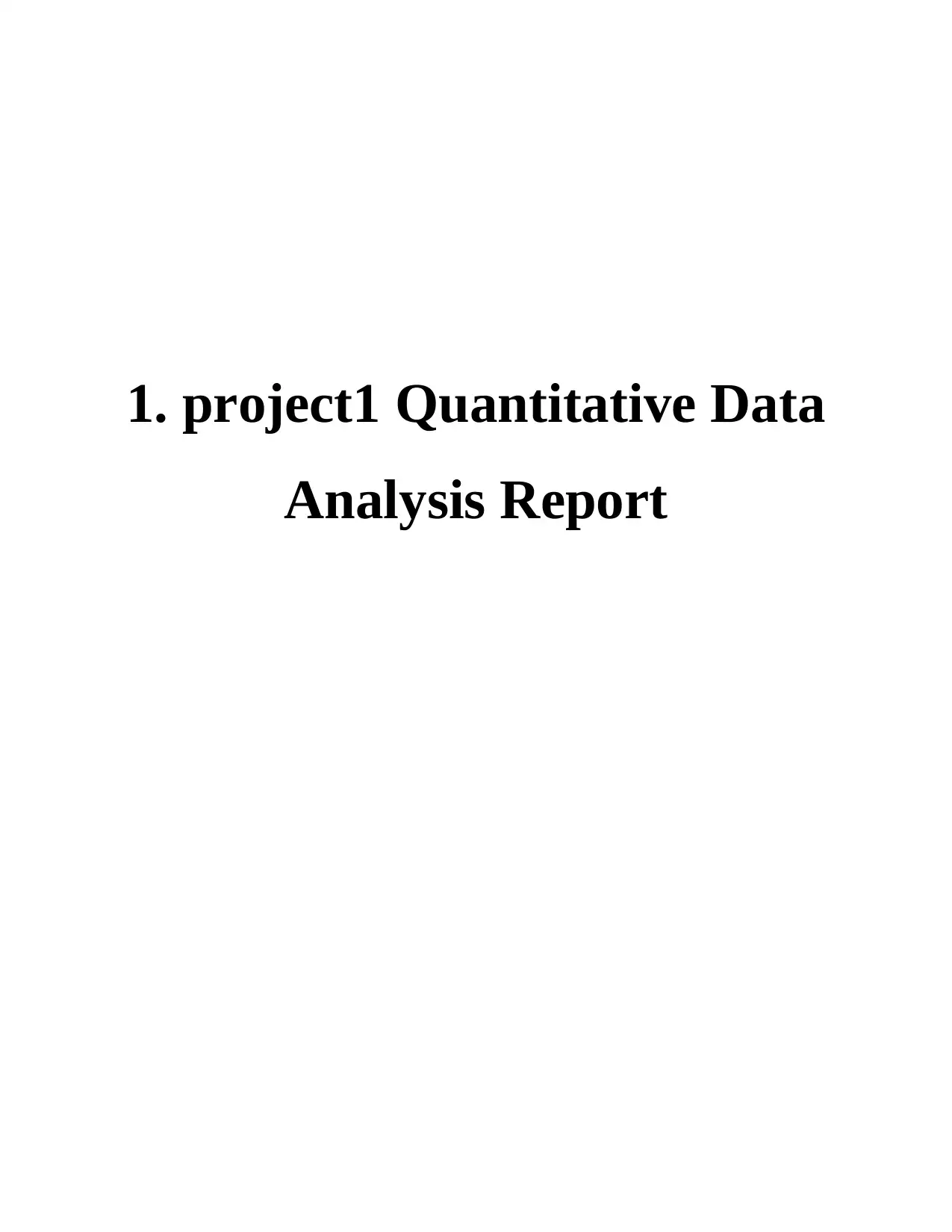
1. project1 Quantitative Data
Analysis Report
Analysis Report
Paraphrase This Document
Need a fresh take? Get an instant paraphrase of this document with our AI Paraphraser
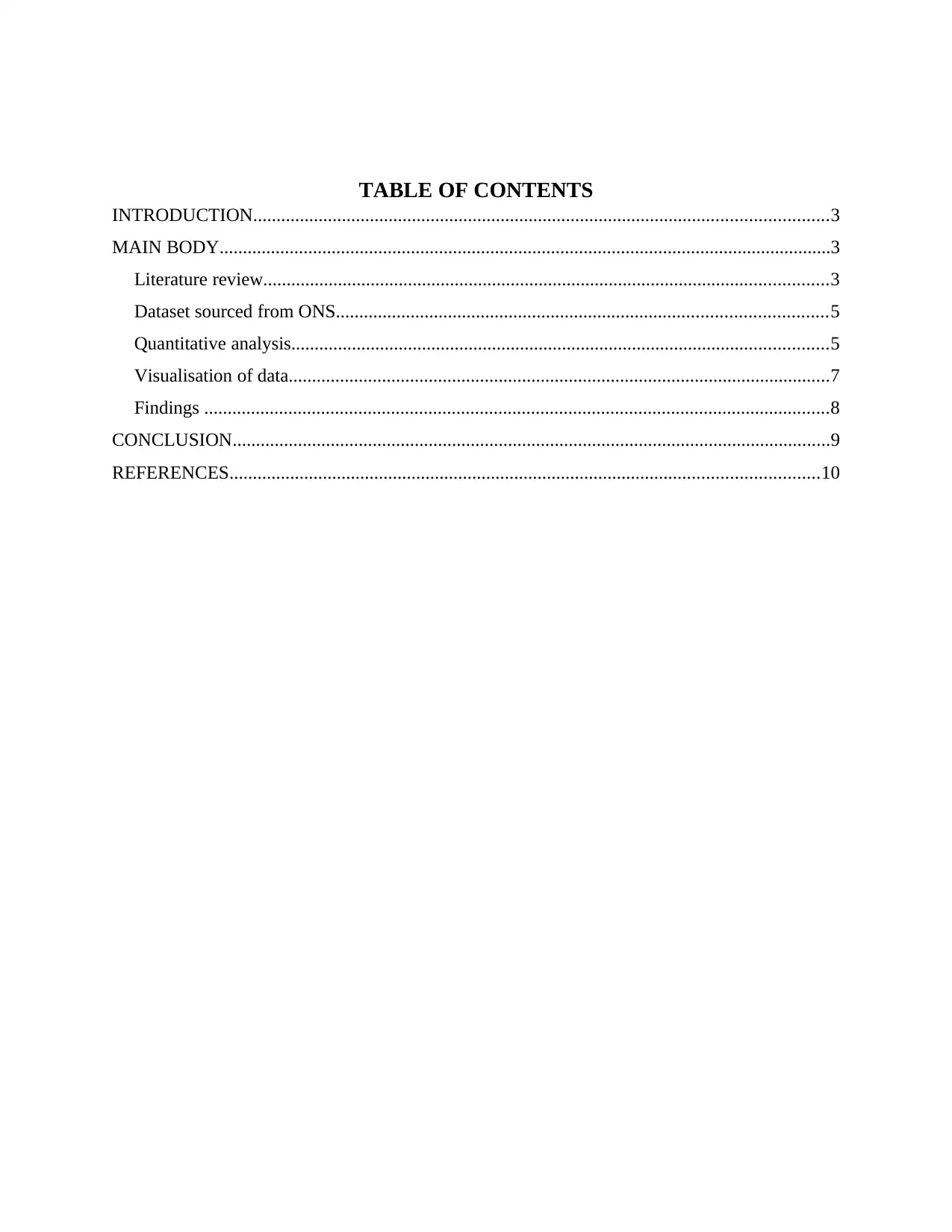
TABLE OF CONTENTS
INTRODUCTION...........................................................................................................................3
MAIN BODY...................................................................................................................................3
Literature review.........................................................................................................................3
Dataset sourced from ONS.........................................................................................................5
Quantitative analysis...................................................................................................................5
Visualisation of data....................................................................................................................7
Findings ......................................................................................................................................8
CONCLUSION................................................................................................................................9
REFERENCES..............................................................................................................................10
INTRODUCTION...........................................................................................................................3
MAIN BODY...................................................................................................................................3
Literature review.........................................................................................................................3
Dataset sourced from ONS.........................................................................................................5
Quantitative analysis...................................................................................................................5
Visualisation of data....................................................................................................................7
Findings ......................................................................................................................................8
CONCLUSION................................................................................................................................9
REFERENCES..............................................................................................................................10
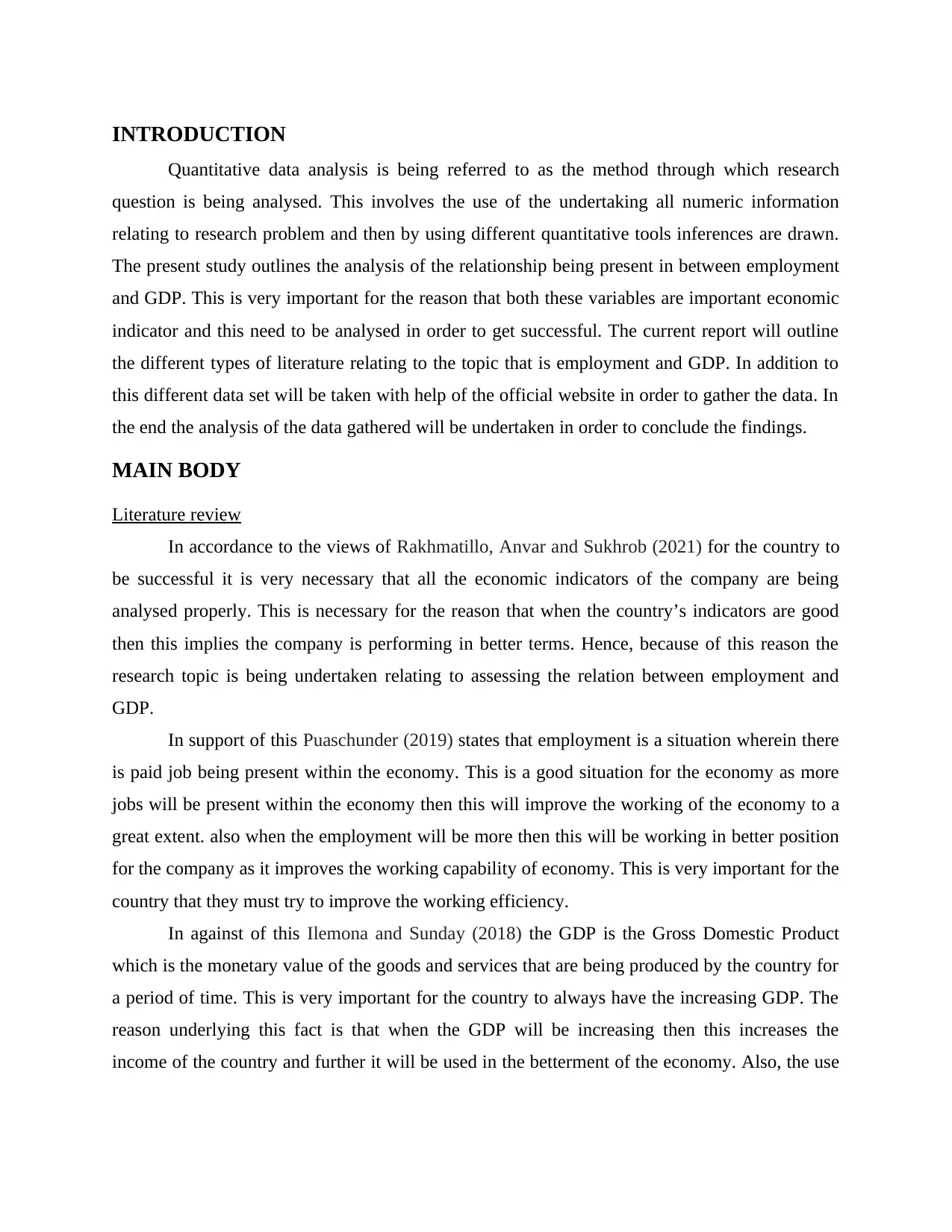
INTRODUCTION
Quantitative data analysis is being referred to as the method through which research
question is being analysed. This involves the use of the undertaking all numeric information
relating to research problem and then by using different quantitative tools inferences are drawn.
The present study outlines the analysis of the relationship being present in between employment
and GDP. This is very important for the reason that both these variables are important economic
indicator and this need to be analysed in order to get successful. The current report will outline
the different types of literature relating to the topic that is employment and GDP. In addition to
this different data set will be taken with help of the official website in order to gather the data. In
the end the analysis of the data gathered will be undertaken in order to conclude the findings.
MAIN BODY
Literature review
In accordance to the views of Rakhmatillo, Anvar and Sukhrob (2021) for the country to
be successful it is very necessary that all the economic indicators of the company are being
analysed properly. This is necessary for the reason that when the country’s indicators are good
then this implies the company is performing in better terms. Hence, because of this reason the
research topic is being undertaken relating to assessing the relation between employment and
GDP.
In support of this Puaschunder (2019) states that employment is a situation wherein there
is paid job being present within the economy. This is a good situation for the economy as more
jobs will be present within the economy then this will improve the working of the economy to a
great extent. also when the employment will be more then this will be working in better position
for the company as it improves the working capability of economy. This is very important for the
country that they must try to improve the working efficiency.
In against of this Ilemona and Sunday (2018) the GDP is the Gross Domestic Product
which is the monetary value of the goods and services that are being produced by the country for
a period of time. This is very important for the country to always have the increasing GDP. The
reason underlying this fact is that when the GDP will be increasing then this increases the
income of the country and further it will be used in the betterment of the economy. Also, the use
Quantitative data analysis is being referred to as the method through which research
question is being analysed. This involves the use of the undertaking all numeric information
relating to research problem and then by using different quantitative tools inferences are drawn.
The present study outlines the analysis of the relationship being present in between employment
and GDP. This is very important for the reason that both these variables are important economic
indicator and this need to be analysed in order to get successful. The current report will outline
the different types of literature relating to the topic that is employment and GDP. In addition to
this different data set will be taken with help of the official website in order to gather the data. In
the end the analysis of the data gathered will be undertaken in order to conclude the findings.
MAIN BODY
Literature review
In accordance to the views of Rakhmatillo, Anvar and Sukhrob (2021) for the country to
be successful it is very necessary that all the economic indicators of the company are being
analysed properly. This is necessary for the reason that when the country’s indicators are good
then this implies the company is performing in better terms. Hence, because of this reason the
research topic is being undertaken relating to assessing the relation between employment and
GDP.
In support of this Puaschunder (2019) states that employment is a situation wherein there
is paid job being present within the economy. This is a good situation for the economy as more
jobs will be present within the economy then this will improve the working of the economy to a
great extent. also when the employment will be more then this will be working in better position
for the company as it improves the working capability of economy. This is very important for the
country that they must try to improve the working efficiency.
In against of this Ilemona and Sunday (2018) the GDP is the Gross Domestic Product
which is the monetary value of the goods and services that are being produced by the country for
a period of time. This is very important for the country to always have the increasing GDP. The
reason underlying this fact is that when the GDP will be increasing then this increases the
income of the country and further it will be used in the betterment of the economy. Also, the use
⊘ This is a preview!⊘
Do you want full access?
Subscribe today to unlock all pages.

Trusted by 1+ million students worldwide
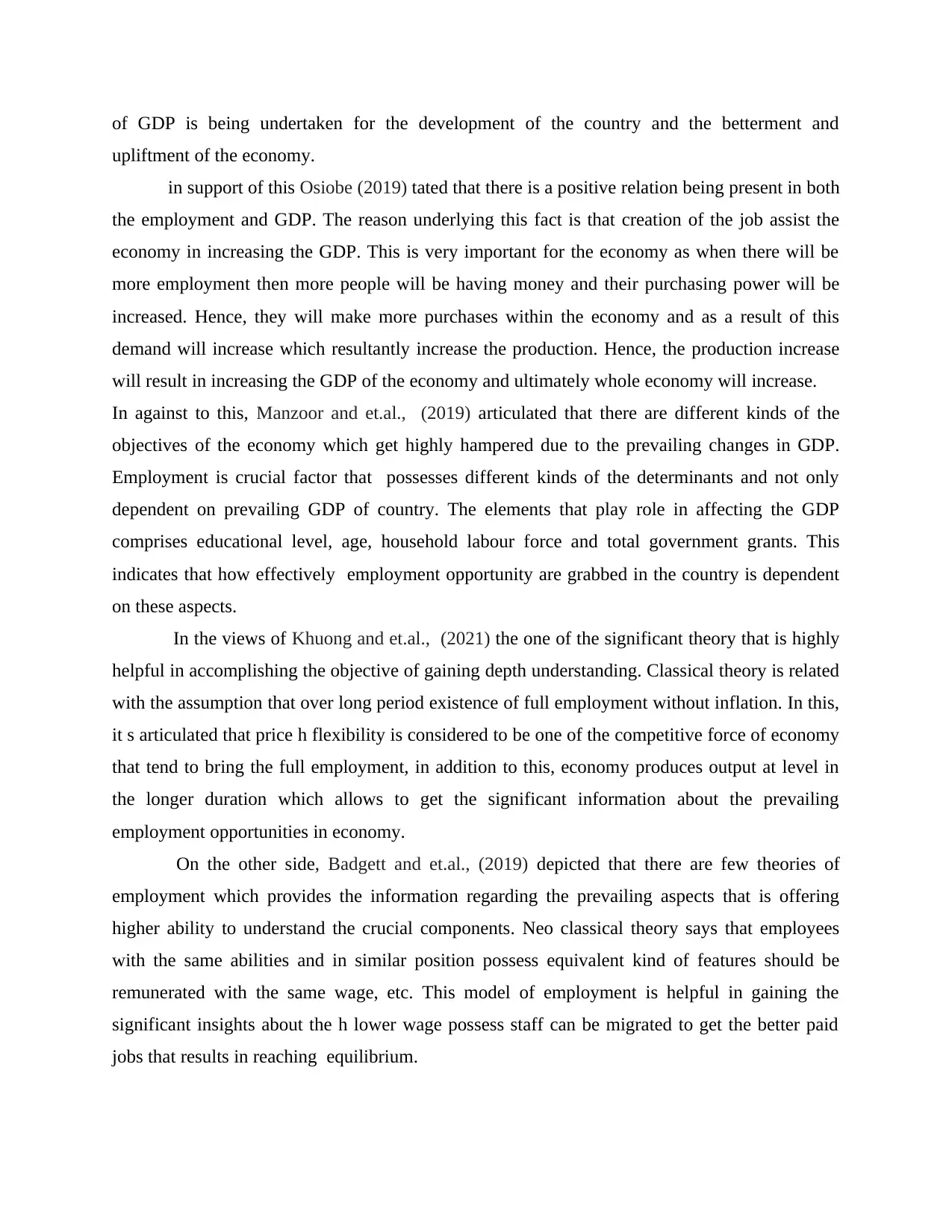
of GDP is being undertaken for the development of the country and the betterment and
upliftment of the economy.
in support of this Osiobe (2019) tated that there is a positive relation being present in both
the employment and GDP. The reason underlying this fact is that creation of the job assist the
economy in increasing the GDP. This is very important for the economy as when there will be
more employment then more people will be having money and their purchasing power will be
increased. Hence, they will make more purchases within the economy and as a result of this
demand will increase which resultantly increase the production. Hence, the production increase
will result in increasing the GDP of the economy and ultimately whole economy will increase.
In against to this, Manzoor and et.al., (2019) articulated that there are different kinds of the
objectives of the economy which get highly hampered due to the prevailing changes in GDP.
Employment is crucial factor that possesses different kinds of the determinants and not only
dependent on prevailing GDP of country. The elements that play role in affecting the GDP
comprises educational level, age, household labour force and total government grants. This
indicates that how effectively employment opportunity are grabbed in the country is dependent
on these aspects.
In the views of Khuong and et.al., (2021) the one of the significant theory that is highly
helpful in accomplishing the objective of gaining depth understanding. Classical theory is related
with the assumption that over long period existence of full employment without inflation. In this,
it s articulated that price h flexibility is considered to be one of the competitive force of economy
that tend to bring the full employment, in addition to this, economy produces output at level in
the longer duration which allows to get the significant information about the prevailing
employment opportunities in economy.
On the other side, Badgett and et.al., (2019) depicted that there are few theories of
employment which provides the information regarding the prevailing aspects that is offering
higher ability to understand the crucial components. Neo classical theory says that employees
with the same abilities and in similar position possess equivalent kind of features should be
remunerated with the same wage, etc. This model of employment is helpful in gaining the
significant insights about the h lower wage possess staff can be migrated to get the better paid
jobs that results in reaching equilibrium.
upliftment of the economy.
in support of this Osiobe (2019) tated that there is a positive relation being present in both
the employment and GDP. The reason underlying this fact is that creation of the job assist the
economy in increasing the GDP. This is very important for the economy as when there will be
more employment then more people will be having money and their purchasing power will be
increased. Hence, they will make more purchases within the economy and as a result of this
demand will increase which resultantly increase the production. Hence, the production increase
will result in increasing the GDP of the economy and ultimately whole economy will increase.
In against to this, Manzoor and et.al., (2019) articulated that there are different kinds of the
objectives of the economy which get highly hampered due to the prevailing changes in GDP.
Employment is crucial factor that possesses different kinds of the determinants and not only
dependent on prevailing GDP of country. The elements that play role in affecting the GDP
comprises educational level, age, household labour force and total government grants. This
indicates that how effectively employment opportunity are grabbed in the country is dependent
on these aspects.
In the views of Khuong and et.al., (2021) the one of the significant theory that is highly
helpful in accomplishing the objective of gaining depth understanding. Classical theory is related
with the assumption that over long period existence of full employment without inflation. In this,
it s articulated that price h flexibility is considered to be one of the competitive force of economy
that tend to bring the full employment, in addition to this, economy produces output at level in
the longer duration which allows to get the significant information about the prevailing
employment opportunities in economy.
On the other side, Badgett and et.al., (2019) depicted that there are few theories of
employment which provides the information regarding the prevailing aspects that is offering
higher ability to understand the crucial components. Neo classical theory says that employees
with the same abilities and in similar position possess equivalent kind of features should be
remunerated with the same wage, etc. This model of employment is helpful in gaining the
significant insights about the h lower wage possess staff can be migrated to get the better paid
jobs that results in reaching equilibrium.
Paraphrase This Document
Need a fresh take? Get an instant paraphrase of this document with our AI Paraphraser
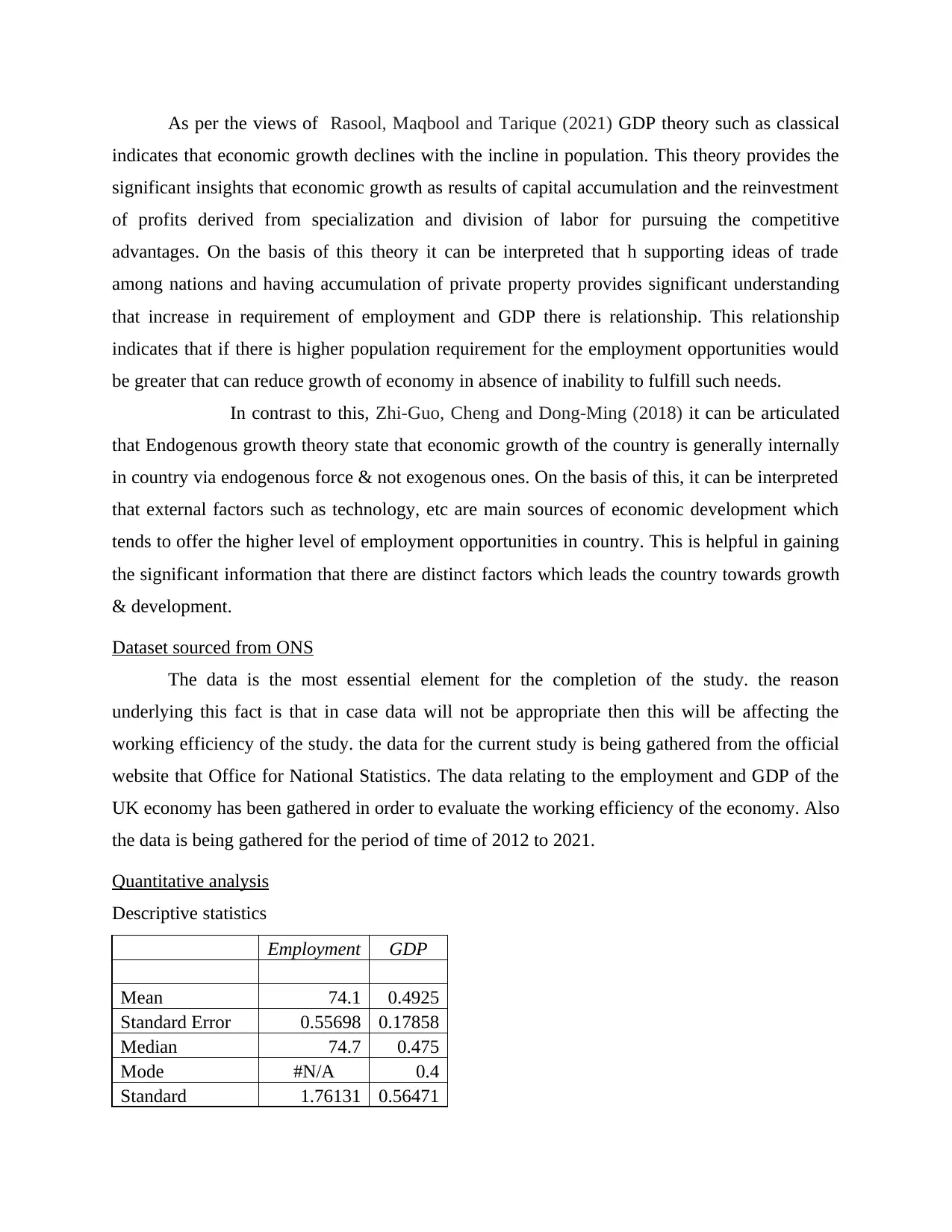
As per the views of Rasool, Maqbool and Tarique (2021) GDP theory such as classical
indicates that economic growth declines with the incline in population. This theory provides the
significant insights that economic growth as results of capital accumulation and the reinvestment
of profits derived from specialization and division of labor for pursuing the competitive
advantages. On the basis of this theory it can be interpreted that h supporting ideas of trade
among nations and having accumulation of private property provides significant understanding
that increase in requirement of employment and GDP there is relationship. This relationship
indicates that if there is higher population requirement for the employment opportunities would
be greater that can reduce growth of economy in absence of inability to fulfill such needs.
In contrast to this, Zhi-Guo, Cheng and Dong-Ming (2018) it can be articulated
that Endogenous growth theory state that economic growth of the country is generally internally
in country via endogenous force & not exogenous ones. On the basis of this, it can be interpreted
that external factors such as technology, etc are main sources of economic development which
tends to offer the higher level of employment opportunities in country. This is helpful in gaining
the significant information that there are distinct factors which leads the country towards growth
& development.
Dataset sourced from ONS
The data is the most essential element for the completion of the study. the reason
underlying this fact is that in case data will not be appropriate then this will be affecting the
working efficiency of the study. the data for the current study is being gathered from the official
website that Office for National Statistics. The data relating to the employment and GDP of the
UK economy has been gathered in order to evaluate the working efficiency of the economy. Also
the data is being gathered for the period of time of 2012 to 2021.
Quantitative analysis
Descriptive statistics
Employment GDP
Mean 74.1 0.4925
Standard Error 0.55698 0.17858
Median 74.7 0.475
Mode #N/A 0.4
Standard 1.76131 0.56471
indicates that economic growth declines with the incline in population. This theory provides the
significant insights that economic growth as results of capital accumulation and the reinvestment
of profits derived from specialization and division of labor for pursuing the competitive
advantages. On the basis of this theory it can be interpreted that h supporting ideas of trade
among nations and having accumulation of private property provides significant understanding
that increase in requirement of employment and GDP there is relationship. This relationship
indicates that if there is higher population requirement for the employment opportunities would
be greater that can reduce growth of economy in absence of inability to fulfill such needs.
In contrast to this, Zhi-Guo, Cheng and Dong-Ming (2018) it can be articulated
that Endogenous growth theory state that economic growth of the country is generally internally
in country via endogenous force & not exogenous ones. On the basis of this, it can be interpreted
that external factors such as technology, etc are main sources of economic development which
tends to offer the higher level of employment opportunities in country. This is helpful in gaining
the significant information that there are distinct factors which leads the country towards growth
& development.
Dataset sourced from ONS
The data is the most essential element for the completion of the study. the reason
underlying this fact is that in case data will not be appropriate then this will be affecting the
working efficiency of the study. the data for the current study is being gathered from the official
website that Office for National Statistics. The data relating to the employment and GDP of the
UK economy has been gathered in order to evaluate the working efficiency of the economy. Also
the data is being gathered for the period of time of 2012 to 2021.
Quantitative analysis
Descriptive statistics
Employment GDP
Mean 74.1 0.4925
Standard Error 0.55698 0.17858
Median 74.7 0.475
Mode #N/A 0.4
Standard 1.76131 0.56471
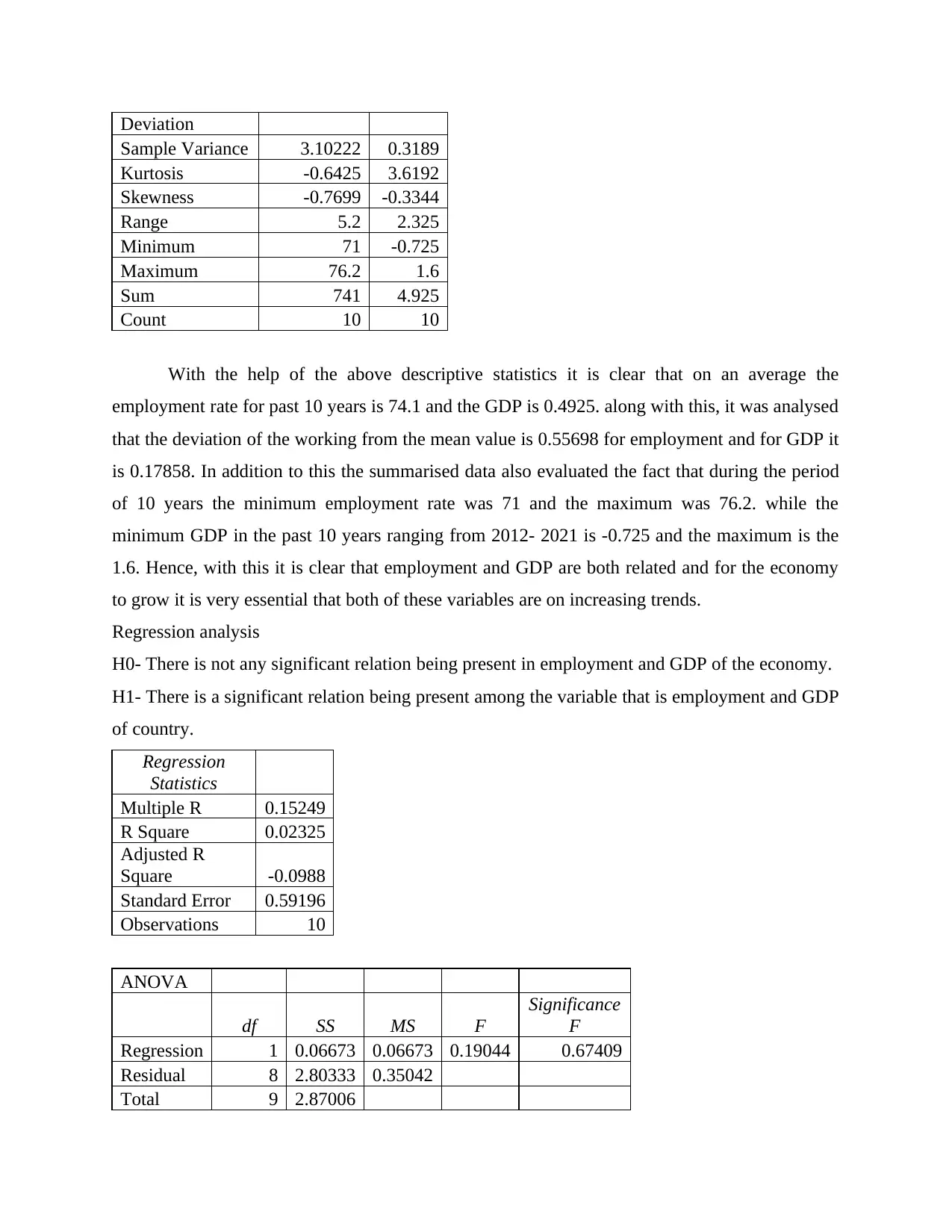
Deviation
Sample Variance 3.10222 0.3189
Kurtosis -0.6425 3.6192
Skewness -0.7699 -0.3344
Range 5.2 2.325
Minimum 71 -0.725
Maximum 76.2 1.6
Sum 741 4.925
Count 10 10
With the help of the above descriptive statistics it is clear that on an average the
employment rate for past 10 years is 74.1 and the GDP is 0.4925. along with this, it was analysed
that the deviation of the working from the mean value is 0.55698 for employment and for GDP it
is 0.17858. In addition to this the summarised data also evaluated the fact that during the period
of 10 years the minimum employment rate was 71 and the maximum was 76.2. while the
minimum GDP in the past 10 years ranging from 2012- 2021 is -0.725 and the maximum is the
1.6. Hence, with this it is clear that employment and GDP are both related and for the economy
to grow it is very essential that both of these variables are on increasing trends.
Regression analysis
H0- There is not any significant relation being present in employment and GDP of the economy.
H1- There is a significant relation being present among the variable that is employment and GDP
of country.
Regression
Statistics
Multiple R 0.15249
R Square 0.02325
Adjusted R
Square -0.0988
Standard Error 0.59196
Observations 10
ANOVA
df SS MS F
Significance
F
Regression 1 0.06673 0.06673 0.19044 0.67409
Residual 8 2.80333 0.35042
Total 9 2.87006
Sample Variance 3.10222 0.3189
Kurtosis -0.6425 3.6192
Skewness -0.7699 -0.3344
Range 5.2 2.325
Minimum 71 -0.725
Maximum 76.2 1.6
Sum 741 4.925
Count 10 10
With the help of the above descriptive statistics it is clear that on an average the
employment rate for past 10 years is 74.1 and the GDP is 0.4925. along with this, it was analysed
that the deviation of the working from the mean value is 0.55698 for employment and for GDP it
is 0.17858. In addition to this the summarised data also evaluated the fact that during the period
of 10 years the minimum employment rate was 71 and the maximum was 76.2. while the
minimum GDP in the past 10 years ranging from 2012- 2021 is -0.725 and the maximum is the
1.6. Hence, with this it is clear that employment and GDP are both related and for the economy
to grow it is very essential that both of these variables are on increasing trends.
Regression analysis
H0- There is not any significant relation being present in employment and GDP of the economy.
H1- There is a significant relation being present among the variable that is employment and GDP
of country.
Regression
Statistics
Multiple R 0.15249
R Square 0.02325
Adjusted R
Square -0.0988
Standard Error 0.59196
Observations 10
ANOVA
df SS MS F
Significance
F
Regression 1 0.06673 0.06673 0.19044 0.67409
Residual 8 2.80333 0.35042
Total 9 2.87006
⊘ This is a preview!⊘
Do you want full access?
Subscribe today to unlock all pages.

Trusted by 1+ million students worldwide
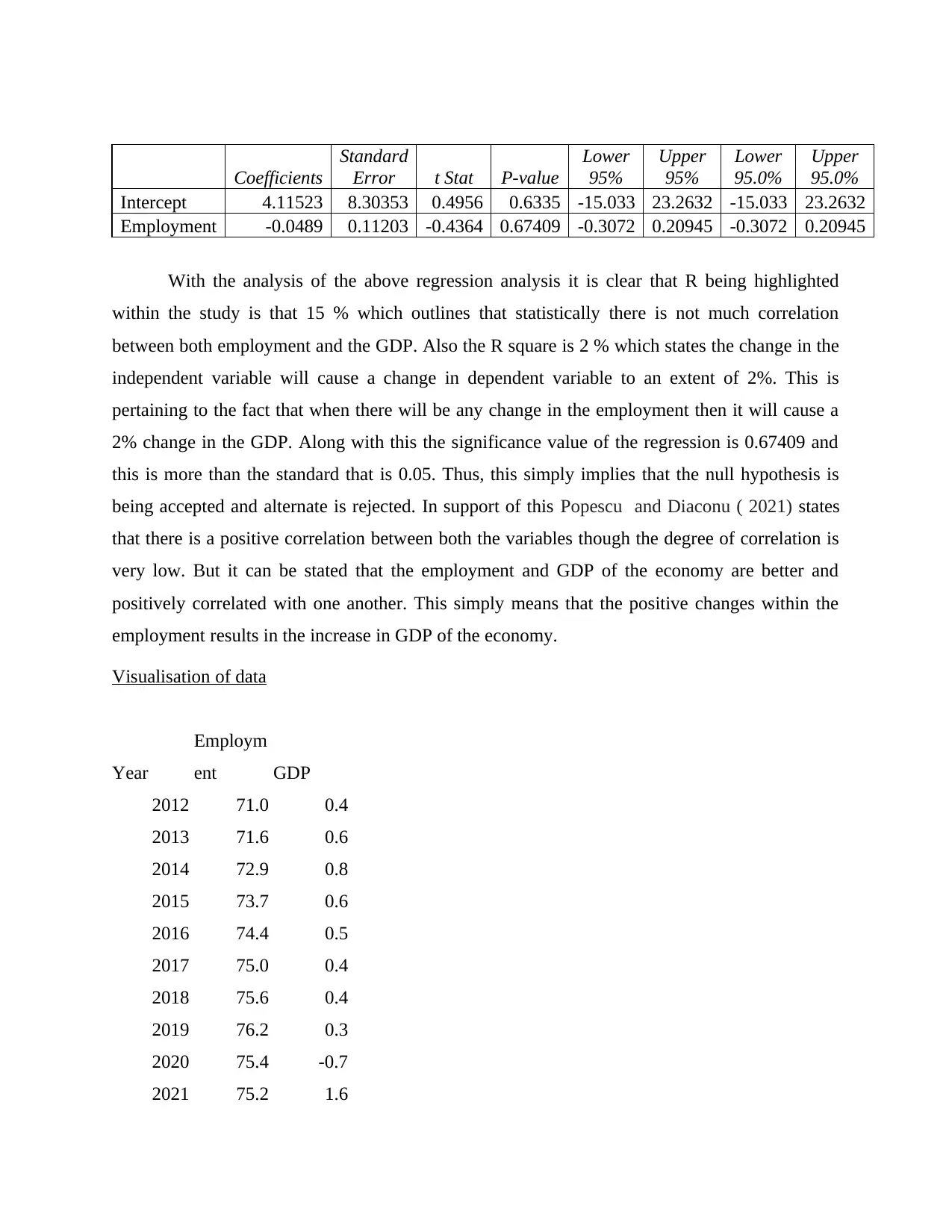
Coefficients
Standard
Error t Stat P-value
Lower
95%
Upper
95%
Lower
95.0%
Upper
95.0%
Intercept 4.11523 8.30353 0.4956 0.6335 -15.033 23.2632 -15.033 23.2632
Employment -0.0489 0.11203 -0.4364 0.67409 -0.3072 0.20945 -0.3072 0.20945
With the analysis of the above regression analysis it is clear that R being highlighted
within the study is that 15 % which outlines that statistically there is not much correlation
between both employment and the GDP. Also the R square is 2 % which states the change in the
independent variable will cause a change in dependent variable to an extent of 2%. This is
pertaining to the fact that when there will be any change in the employment then it will cause a
2% change in the GDP. Along with this the significance value of the regression is 0.67409 and
this is more than the standard that is 0.05. Thus, this simply implies that the null hypothesis is
being accepted and alternate is rejected. In support of this Popescu and Diaconu ( 2021) states
that there is a positive correlation between both the variables though the degree of correlation is
very low. But it can be stated that the employment and GDP of the economy are better and
positively correlated with one another. This simply means that the positive changes within the
employment results in the increase in GDP of the economy.
Visualisation of data
Year
Employm
ent GDP
2012 71.0 0.4
2013 71.6 0.6
2014 72.9 0.8
2015 73.7 0.6
2016 74.4 0.5
2017 75.0 0.4
2018 75.6 0.4
2019 76.2 0.3
2020 75.4 -0.7
2021 75.2 1.6
Standard
Error t Stat P-value
Lower
95%
Upper
95%
Lower
95.0%
Upper
95.0%
Intercept 4.11523 8.30353 0.4956 0.6335 -15.033 23.2632 -15.033 23.2632
Employment -0.0489 0.11203 -0.4364 0.67409 -0.3072 0.20945 -0.3072 0.20945
With the analysis of the above regression analysis it is clear that R being highlighted
within the study is that 15 % which outlines that statistically there is not much correlation
between both employment and the GDP. Also the R square is 2 % which states the change in the
independent variable will cause a change in dependent variable to an extent of 2%. This is
pertaining to the fact that when there will be any change in the employment then it will cause a
2% change in the GDP. Along with this the significance value of the regression is 0.67409 and
this is more than the standard that is 0.05. Thus, this simply implies that the null hypothesis is
being accepted and alternate is rejected. In support of this Popescu and Diaconu ( 2021) states
that there is a positive correlation between both the variables though the degree of correlation is
very low. But it can be stated that the employment and GDP of the economy are better and
positively correlated with one another. This simply means that the positive changes within the
employment results in the increase in GDP of the economy.
Visualisation of data
Year
Employm
ent GDP
2012 71.0 0.4
2013 71.6 0.6
2014 72.9 0.8
2015 73.7 0.6
2016 74.4 0.5
2017 75.0 0.4
2018 75.6 0.4
2019 76.2 0.3
2020 75.4 -0.7
2021 75.2 1.6
Paraphrase This Document
Need a fresh take? Get an instant paraphrase of this document with our AI Paraphraser
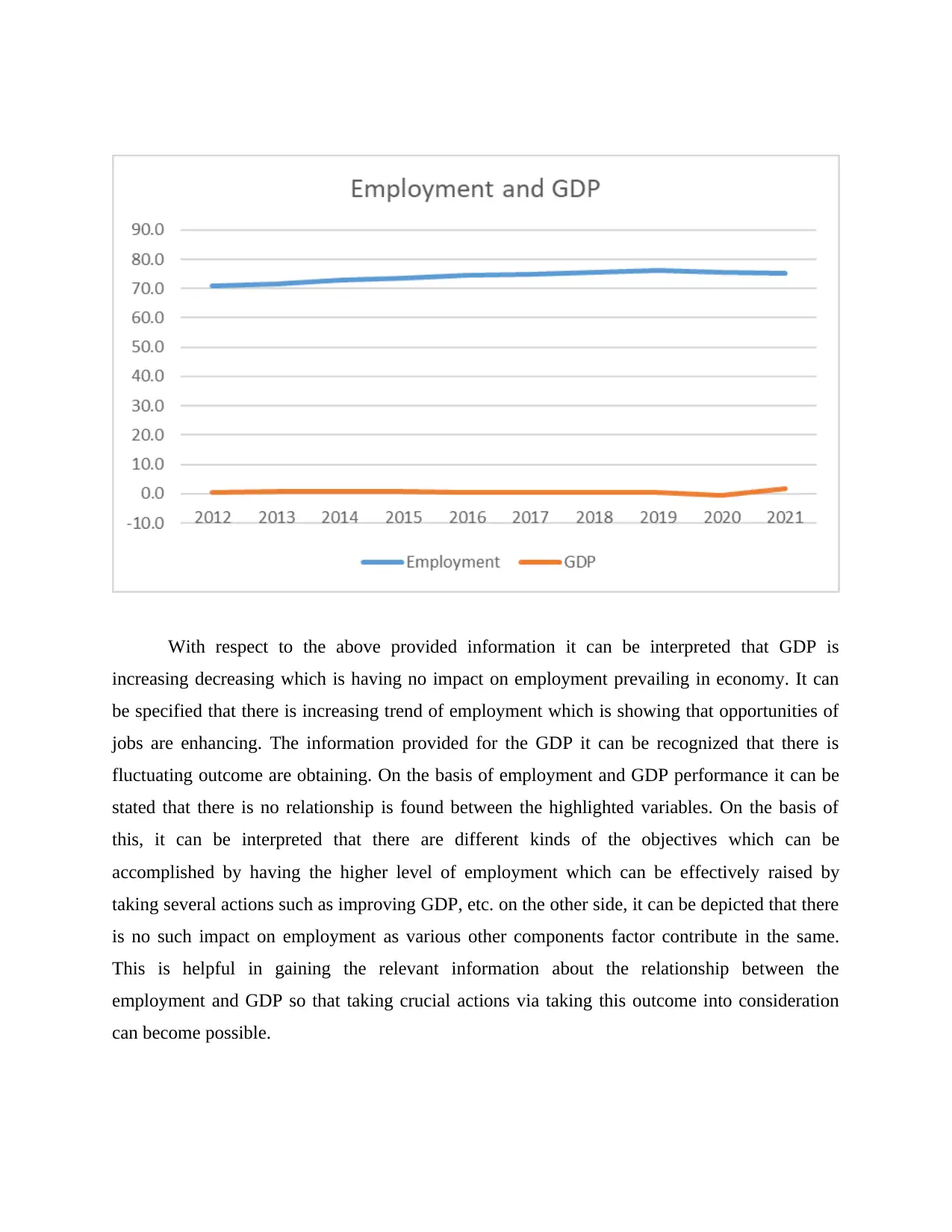
With respect to the above provided information it can be interpreted that GDP is
increasing decreasing which is having no impact on employment prevailing in economy. It can
be specified that there is increasing trend of employment which is showing that opportunities of
jobs are enhancing. The information provided for the GDP it can be recognized that there is
fluctuating outcome are obtaining. On the basis of employment and GDP performance it can be
stated that there is no relationship is found between the highlighted variables. On the basis of
this, it can be interpreted that there are different kinds of the objectives which can be
accomplished by having the higher level of employment which can be effectively raised by
taking several actions such as improving GDP, etc. on the other side, it can be depicted that there
is no such impact on employment as various other components factor contribute in the same.
This is helpful in gaining the relevant information about the relationship between the
employment and GDP so that taking crucial actions via taking this outcome into consideration
can become possible.
increasing decreasing which is having no impact on employment prevailing in economy. It can
be specified that there is increasing trend of employment which is showing that opportunities of
jobs are enhancing. The information provided for the GDP it can be recognized that there is
fluctuating outcome are obtaining. On the basis of employment and GDP performance it can be
stated that there is no relationship is found between the highlighted variables. On the basis of
this, it can be interpreted that there are different kinds of the objectives which can be
accomplished by having the higher level of employment which can be effectively raised by
taking several actions such as improving GDP, etc. on the other side, it can be depicted that there
is no such impact on employment as various other components factor contribute in the same.
This is helpful in gaining the relevant information about the relationship between the
employment and GDP so that taking crucial actions via taking this outcome into consideration
can become possible.
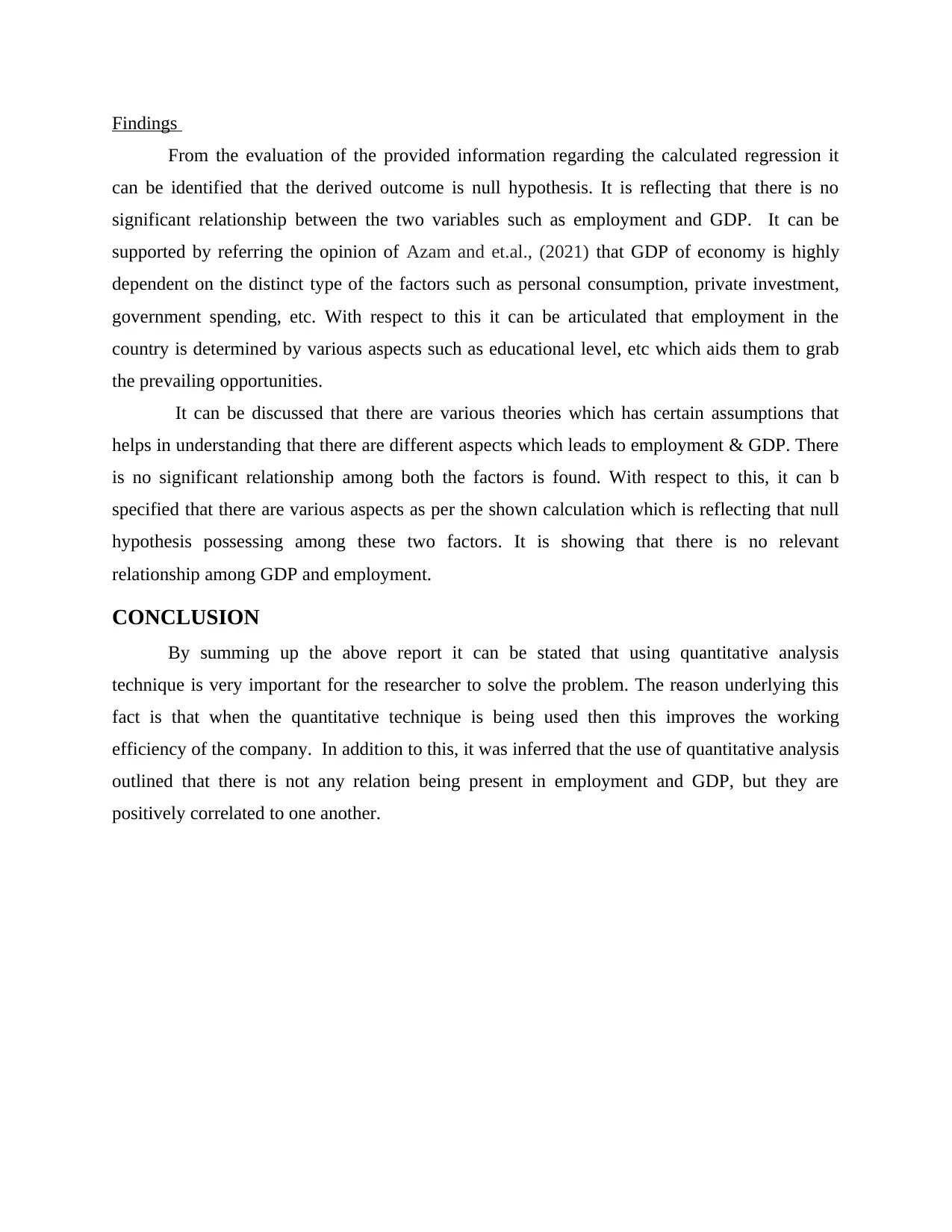
Findings
From the evaluation of the provided information regarding the calculated regression it
can be identified that the derived outcome is null hypothesis. It is reflecting that there is no
significant relationship between the two variables such as employment and GDP. It can be
supported by referring the opinion of Azam and et.al., (2021) that GDP of economy is highly
dependent on the distinct type of the factors such as personal consumption, private investment,
government spending, etc. With respect to this it can be articulated that employment in the
country is determined by various aspects such as educational level, etc which aids them to grab
the prevailing opportunities.
It can be discussed that there are various theories which has certain assumptions that
helps in understanding that there are different aspects which leads to employment & GDP. There
is no significant relationship among both the factors is found. With respect to this, it can b
specified that there are various aspects as per the shown calculation which is reflecting that null
hypothesis possessing among these two factors. It is showing that there is no relevant
relationship among GDP and employment.
CONCLUSION
By summing up the above report it can be stated that using quantitative analysis
technique is very important for the researcher to solve the problem. The reason underlying this
fact is that when the quantitative technique is being used then this improves the working
efficiency of the company. In addition to this, it was inferred that the use of quantitative analysis
outlined that there is not any relation being present in employment and GDP, but they are
positively correlated to one another.
From the evaluation of the provided information regarding the calculated regression it
can be identified that the derived outcome is null hypothesis. It is reflecting that there is no
significant relationship between the two variables such as employment and GDP. It can be
supported by referring the opinion of Azam and et.al., (2021) that GDP of economy is highly
dependent on the distinct type of the factors such as personal consumption, private investment,
government spending, etc. With respect to this it can be articulated that employment in the
country is determined by various aspects such as educational level, etc which aids them to grab
the prevailing opportunities.
It can be discussed that there are various theories which has certain assumptions that
helps in understanding that there are different aspects which leads to employment & GDP. There
is no significant relationship among both the factors is found. With respect to this, it can b
specified that there are various aspects as per the shown calculation which is reflecting that null
hypothesis possessing among these two factors. It is showing that there is no relevant
relationship among GDP and employment.
CONCLUSION
By summing up the above report it can be stated that using quantitative analysis
technique is very important for the researcher to solve the problem. The reason underlying this
fact is that when the quantitative technique is being used then this improves the working
efficiency of the company. In addition to this, it was inferred that the use of quantitative analysis
outlined that there is not any relation being present in employment and GDP, but they are
positively correlated to one another.
⊘ This is a preview!⊘
Do you want full access?
Subscribe today to unlock all pages.

Trusted by 1+ million students worldwide
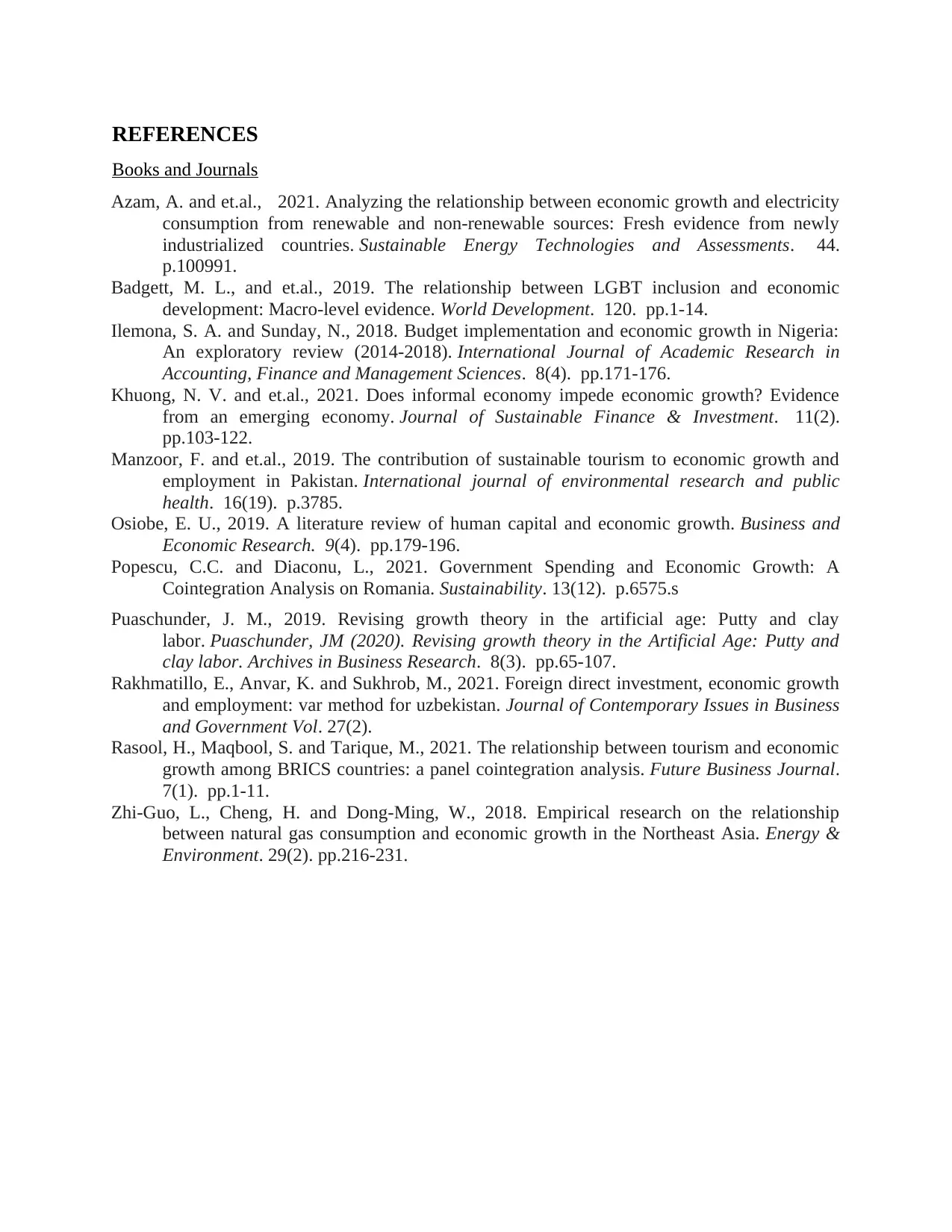
REFERENCES
Books and Journals
Azam, A. and et.al., 2021. Analyzing the relationship between economic growth and electricity
consumption from renewable and non-renewable sources: Fresh evidence from newly
industrialized countries. Sustainable Energy Technologies and Assessments. 44.
p.100991.
Badgett, M. L., and et.al., 2019. The relationship between LGBT inclusion and economic
development: Macro-level evidence. World Development. 120. pp.1-14.
Ilemona, S. A. and Sunday, N., 2018. Budget implementation and economic growth in Nigeria:
An exploratory review (2014-2018). International Journal of Academic Research in
Accounting, Finance and Management Sciences. 8(4). pp.171-176.
Khuong, N. V. and et.al., 2021. Does informal economy impede economic growth? Evidence
from an emerging economy. Journal of Sustainable Finance & Investment. 11(2).
pp.103-122.
Manzoor, F. and et.al., 2019. The contribution of sustainable tourism to economic growth and
employment in Pakistan. International journal of environmental research and public
health. 16(19). p.3785.
Osiobe, E. U., 2019. A literature review of human capital and economic growth. Business and
Economic Research. 9(4). pp.179-196.
Popescu, C.C. and Diaconu, L., 2021. Government Spending and Economic Growth: A
Cointegration Analysis on Romania. Sustainability. 13(12). p.6575.s
Puaschunder, J. M., 2019. Revising growth theory in the artificial age: Putty and clay
labor. Puaschunder, JM (2020). Revising growth theory in the Artificial Age: Putty and
clay labor. Archives in Business Research. 8(3). pp.65-107.
Rakhmatillo, E., Anvar, K. and Sukhrob, M., 2021. Foreign direct investment, economic growth
and employment: var method for uzbekistan. Journal of Contemporary Issues in Business
and Government Vol. 27(2).
Rasool, H., Maqbool, S. and Tarique, M., 2021. The relationship between tourism and economic
growth among BRICS countries: a panel cointegration analysis. Future Business Journal.
7(1). pp.1-11.
Zhi-Guo, L., Cheng, H. and Dong-Ming, W., 2018. Empirical research on the relationship
between natural gas consumption and economic growth in the Northeast Asia. Energy &
Environment. 29(2). pp.216-231.
Books and Journals
Azam, A. and et.al., 2021. Analyzing the relationship between economic growth and electricity
consumption from renewable and non-renewable sources: Fresh evidence from newly
industrialized countries. Sustainable Energy Technologies and Assessments. 44.
p.100991.
Badgett, M. L., and et.al., 2019. The relationship between LGBT inclusion and economic
development: Macro-level evidence. World Development. 120. pp.1-14.
Ilemona, S. A. and Sunday, N., 2018. Budget implementation and economic growth in Nigeria:
An exploratory review (2014-2018). International Journal of Academic Research in
Accounting, Finance and Management Sciences. 8(4). pp.171-176.
Khuong, N. V. and et.al., 2021. Does informal economy impede economic growth? Evidence
from an emerging economy. Journal of Sustainable Finance & Investment. 11(2).
pp.103-122.
Manzoor, F. and et.al., 2019. The contribution of sustainable tourism to economic growth and
employment in Pakistan. International journal of environmental research and public
health. 16(19). p.3785.
Osiobe, E. U., 2019. A literature review of human capital and economic growth. Business and
Economic Research. 9(4). pp.179-196.
Popescu, C.C. and Diaconu, L., 2021. Government Spending and Economic Growth: A
Cointegration Analysis on Romania. Sustainability. 13(12). p.6575.s
Puaschunder, J. M., 2019. Revising growth theory in the artificial age: Putty and clay
labor. Puaschunder, JM (2020). Revising growth theory in the Artificial Age: Putty and
clay labor. Archives in Business Research. 8(3). pp.65-107.
Rakhmatillo, E., Anvar, K. and Sukhrob, M., 2021. Foreign direct investment, economic growth
and employment: var method for uzbekistan. Journal of Contemporary Issues in Business
and Government Vol. 27(2).
Rasool, H., Maqbool, S. and Tarique, M., 2021. The relationship between tourism and economic
growth among BRICS countries: a panel cointegration analysis. Future Business Journal.
7(1). pp.1-11.
Zhi-Guo, L., Cheng, H. and Dong-Ming, W., 2018. Empirical research on the relationship
between natural gas consumption and economic growth in the Northeast Asia. Energy &
Environment. 29(2). pp.216-231.
1 out of 10
Related Documents
Your All-in-One AI-Powered Toolkit for Academic Success.
+13062052269
info@desklib.com
Available 24*7 on WhatsApp / Email
![[object Object]](/_next/static/media/star-bottom.7253800d.svg)
Unlock your academic potential
Copyright © 2020–2025 A2Z Services. All Rights Reserved. Developed and managed by ZUCOL.



